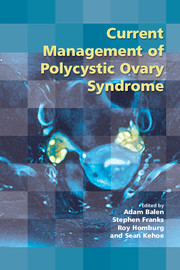Book contents
- Frontmatter
- Contents
- Participants
- Declarations of personal interest
- Preface
- 1 Overview and definitions of polycystic ovary syndrome and the polycystic ovary
- 2 Genetics and pathogenesis of polycystic ovary syndrome
- 3 Ethnic variations in the expression of polycystic ovary syndrome
- 4 Quality of life for women with polycystic ovary syndrome
- 5 Insulin resistance, the metabolic syndrome and polycystic ovary syndrome
- 6 Management of polycystic ovary syndrome through puberty and adolescence
- 7 Long-term health risks of polycystic ovary syndrome
- 8 Approaches to lifestyle management in polycystic ovary syndrome
- 9 Management of obesity in polycystic ovary syndrome, including anti-obesity drugs and bariatric surgery
- 10 Definition of hyperandrogenism
- 11 Treatment of hyperandrogenism in polycystic ovary syndrome
- 12 Choices in the treatment of anovulatory polycystic ovary syndrome
- 13 Predictors of ovarian response to ovarian stimulation: progress towards individualised treatment in ovulation induction
- 14 Surgical management of anovulatory infertility in polycystic ovary syndrome
- 15 The role of insulin-sensitising drugs in the treatment of polycystic ovary syndrome
- 16 The role of in vitro maturation of oocytes for anovulatory polycystic ovary syndrome
- 17 Acupuncture and/or herbal therapy as an alternative or complement for relief of polycystic ovary syndrome-related symptoms
- 18 Consensus views arising from the 59th Study Group: Current Management of Polycystic Ovary Syndrome
- Index
4 - Quality of life for women with polycystic ovary syndrome
Published online by Cambridge University Press: 05 July 2014
- Frontmatter
- Contents
- Participants
- Declarations of personal interest
- Preface
- 1 Overview and definitions of polycystic ovary syndrome and the polycystic ovary
- 2 Genetics and pathogenesis of polycystic ovary syndrome
- 3 Ethnic variations in the expression of polycystic ovary syndrome
- 4 Quality of life for women with polycystic ovary syndrome
- 5 Insulin resistance, the metabolic syndrome and polycystic ovary syndrome
- 6 Management of polycystic ovary syndrome through puberty and adolescence
- 7 Long-term health risks of polycystic ovary syndrome
- 8 Approaches to lifestyle management in polycystic ovary syndrome
- 9 Management of obesity in polycystic ovary syndrome, including anti-obesity drugs and bariatric surgery
- 10 Definition of hyperandrogenism
- 11 Treatment of hyperandrogenism in polycystic ovary syndrome
- 12 Choices in the treatment of anovulatory polycystic ovary syndrome
- 13 Predictors of ovarian response to ovarian stimulation: progress towards individualised treatment in ovulation induction
- 14 Surgical management of anovulatory infertility in polycystic ovary syndrome
- 15 The role of insulin-sensitising drugs in the treatment of polycystic ovary syndrome
- 16 The role of in vitro maturation of oocytes for anovulatory polycystic ovary syndrome
- 17 Acupuncture and/or herbal therapy as an alternative or complement for relief of polycystic ovary syndrome-related symptoms
- 18 Consensus views arising from the 59th Study Group: Current Management of Polycystic Ovary Syndrome
- Index
Summary
Introduction
Polycystic ovary syndrome (PCOS) is the most common chronic endocrine disorder affecting women of reproductive age. Depending on the definitions used for diagnosis, the prevalence of the condition is estimated to be between 4% and 25%. The two main sets of symptoms typically associated with PCOS are disruption to fertility resulting from irregular menses (oligomenorrhoea) or absence of menstruation (anovulation) and clinical signs of hyperandrogenism (including hirsutism, acne and alopecia). There may be secondary metabolic problems related to obesity and insulin resistance. This combination of outwardly visible and reproduction-inhibiting symptoms makes PCOS a particular distressing disorder suffered by a large number of women. For example, acne and hirsutism have been identified as major causes of social and emotional stress and psychological morbidity. Irregular menses and infertility issues have been suggested to cause tensions within the family, altered self-perception, impaired sexual functioning and problems in the workplace.
As there is currently no cure, the management of PCOS is directed towards improving the woman's health-related quality of life (HRQoL) by means of alleviation of symptoms and prevention of long-term complications. From patients’ own perceptions, HRQoL provides the metric through which effectiveness of management of the disorder is assessed, rather than assessment of clinical efficacy. Given the nature of the condition, it is perhaps not surprising that in recent years there has been a growing interest in the impact of PCOS on the HRQoL of women with the condition.
- Type
- Chapter
- Information
- Current Management of Polycystic Ovary Syndrome , pp. 47 - 62Publisher: Cambridge University PressPrint publication year: 2010



